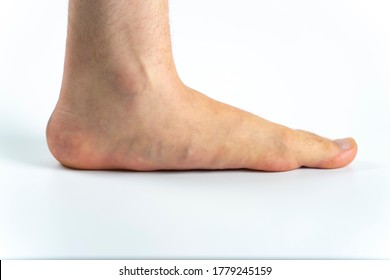

We will send patients away when an insole is not appropriate, if a patient is suffering with iliotibial band syndrome for example, the problem can be helped with physiotherapy and a stretching programme. Alternatively, they can be considered as an option prior to surgery. Wanneer de achtervoet ook naar binnen kantelt. Dieser Text wurde nach bestem Wissen und Gewissen. 1: Die drei Komponente der Pes planovalgus-Fehlstellung: das Fußgewölbe ist aufgehoben (3), die Ferse ist nach außen geneigt (4) und der Vorfuß weicht nach außen ab (2). The indications were posterior tibial tendon dysfunction (seven feet), rheumatoid arthritis (three feet), post-traumatic arthritis and deformity (one foot), congenital pes planovalgus (one foot), and tarsal coalition (one foot). Der komplette Begriff (Pes planovalgus et abductus) beschreibt die Fehlstellung mit all ihren Facetten (s. Normaliter staat een deel van de binnenzijde van de voet iets af van de grond wanneer men staat. The average patient age was 55 (range 27 to 77) years. De binnenzijde van de voet kantelt naar beneden en de gehele binnenzijde van de voet staat plat op de grond. Acquired bilateral flat foot Acquired bilateral pes planus Acquired pes planus of bilateral foot Acquired pes planus of right foot Acquired right flat foot.
#Pes planovalgus code
They are a non-invasive approach to treatment and in many cases, are a great option for symptoms that are not severe enough to warrant surgical intervention. Platvoeten (pes planovalgus) Een soepele platvoet (pes planus) is een meestal pijnloze voet. pes planus, acquired ( M21.4) ICD-10-CM Diagnosis Code M21.41 convert to ICD-9-CM Flat foot pes planus (acquired), right foot. Everted heel alignment from a Compensated Rearfoot Varus.

Poor alignment to floor, producing a True 'Flat Foot'.

If you have already tried rest, icing, compression and elevation and your feet have not recovered, we recommend a biomechanical assessment to consider the possibility of insoles. The F Quad Foot Type is a severely over-pronated foot type with the following features. The rigid pes planovalgus is often a result of a tarsal coalition, which is typically characterized as a painful unilateral or bilateral deformity, frequently associated with peroneal spasm. If you have symptoms in your feet, ankles, hips or your lower back that are intermittent or were not there to start with in early life, and have started to cause you pain over a period of time, bespoke orthotic insoles could be an excellent option. Pediatric pes planovalgus deformity may be classified as flexible or rigid.


 0 kommentar(er)
0 kommentar(er)
